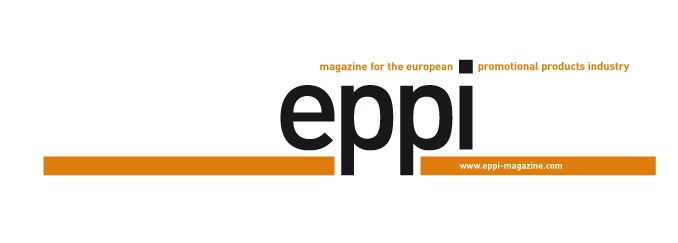WHO estimates the amount of people with a disability worldwide to be 1.3 billion, according to the European Council these include every fourth person in the EU. Nevertheless, people with disabilities are often underrepresented, virtually invisible, in everyday life, in the media and also at promoting companies. So it’s high time to ensure more visibility and place this large group of the population under the spotlight of marketing campaigns and on the labour market. Here, the promotional products industry often sets a good example.
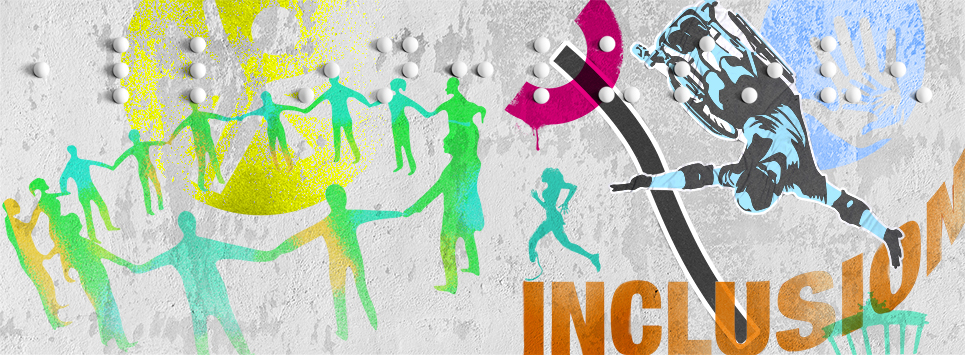
Their share of the world population corresponds to roughly the number of inhabitants of China: According to the WHO definition, around one sixth of humanity go through life with “restrictions in the everyday routine”. According to the official figures of the European Council, 87 million people with a disability live in the EU alone (status as of 2019), with an upwards trend. For people aged 65 and above this even applies to 48% of the EU citizens. The figures that appear astonishingly high to many people, are according to the WHO on the one hand due to the ageing population, but also due to adapted definitions and more extensive und more comprehensive terminology. For example, contrary to the widespread cliches, disability means much more than just being dependent on a wheelchair or a guide dog for the everyday routine. In addition to visible disabilities there is a long list of invisible limitations – from the spectrum of autism through to chronic illnesses like depression, that impede participation in society.
In spite of their omnipresence, the fact that disabilities are considered to be a fringe area, is probably due to the lacking social representation and due to their (in)visibility in the advertising world: For instance, according to a survey by the consulting company, Nielsen, carried out in February 2021, every fourth American has a disability, but only approx. 1% of the people shown in TV adverts during prime time has a disability. About 50% of these corresponding advertising spots are placed by the health industry, people with disabilities are quasi not represented in lifestyle themes. But the promoting companies don’t do themselves a favour by neglecting or more or less totally blanking such a large, widely fragmented social group. The value of the purple pound, which records the buying power of the households of people with a disability, has been communicated throughout Great Britain for many years. According to the latest figures published at www.wearepurple.org.uk, the annual buying power of the corresponding households is estimated to be 274 billion British Pounds (approx. 310 billion Euros). Alone via the online business, British companies miss out on approx. 17 billion Pounds (approx. 19 billion Euros) for instance due to lacking accessibility and customer friendliness.
Making the invisible visible
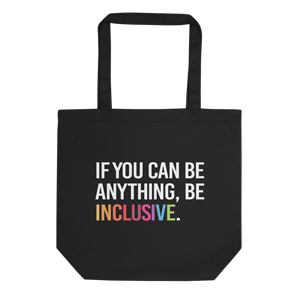
URevolution offers promoting companies the opportunity to encounter the theme inclusion with contemporary designs and also creates new, individual motifs under the company’s name.
Among others, Corinne Gray sees this untapped potential as a target group. The founder and Managing Director of URevolution (short for Uncomfortable Revolution) lives with a disability herself and after her husband Brendan Mc- Donald was diagnosed with cancer, she and her husband jointly published the book called Glossary of Awkward that deals with addressing a cancer diagnosis. She then published the Diversity & Inclusion Disability Magazine and (video) podcast formats for real talk about chronic diseases and disabilities and – to back this content financially – together with her company founded in 2018, URevolution, she designs statement fashion items and accessories on the theme of disability and chronic diseases. Gray states: “Society ignores people with disabilities. We want to communicate what living with a disability or chronic illness is actually like and to demonstrate that companies are also missing out on a huge market. People with disabilities are often left out when it comes to diversity marketing and D,E&I management in companies (diversity, equity & inclusion). But we deserve to be seen.” If disabilities are addressed, Gray stated that it is normally in a medical or charity-related context, which excludes the actual living environment of the people. This is why she has set herself the goal of reporting from the community for the community in a contemporary way, while at the same addressing a wide spectrum of social themes. Gray wants to enable promoting companies to do the same – to encounter people with a disability, for instance who work in the company, who they want to reach via campaigns or events with contemporary haptic advertising. “Fashion and merchandise for people with disabilities is often very functional. At URevolution we focus on beautiful designs to give the community the promotional fashion it deserves. We want to have the same shiny things as everybody else.”
URevolution has already been able to win over renowned companies and organisations like the Canadian High Commission, the famous American private school Andover Academy or the brand Sunglass Hut as customers with its approach. In addition to fashion items like Tshirts, hoodies and bags, the product range also encompasses home accessories from candles to cushions. All of the items display attractive designs that pick up on the theme disabilities in a topical manner – i.e. bearing the infinity symbol for the neurodivergent community – the majority of which Gray designs herself. “The designs are created by us, but we don’t produce the items ourselves. Instead, we work with print-ondemand providers. Our T-shirts and water bottles are in high demand with our B2B customers, but stickers and buttons are also very popular for example for event marketing purposes. Companies and organisations are increasingly communicating their D,E&I efforts and we do see a growing demand. In fashion and the media, disability is becoming more and more visible as well, if you think about adaptive fashion at Tommy Hilfiger and Zappos or popular Netflix shows with disabled actors.” Gray welcomes the trend to focus more on people with disabilities in (promotional) communication. After all it is the person who counts first, not the disability or the “special needs” of a very heterogeneous target group.
New perspectives
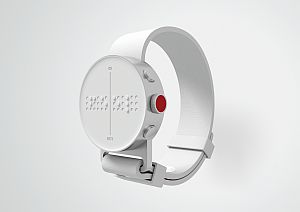
Making the digital world accessible: Serviceplan and Dot Inc. created Dot smartwatches and tablets, which translate digital content into Braille.
Marketing campaigns with a contemporary target group approach and haptic messengers beyond health or charity-related topics can be found for people with visual impairment and blind people, among others. For example the British Royal National Institute for the Blind (RNIB) uses the slogan “See the person, not the sight loss” in its advertising campaigns. And the See Differently campaign for the RNIB by the London-based agency, The&Partnership, which has been running for several years with diverse campaign concepts, picks up on the everyday routine of visually impaired people, among others using the Life Hack products of the campaign that were presented at the beginning of 2020: Created as designer objects that make a world that is mostly determined by sighted people more readily accessible for the visual impaired. The product developments of the agency Serviceplan and the South Korean technology company Dot Inc. on the other hand aim to improve the accessibility of digital everyday life: In cooperation, they initially produced Dot Watch in 2016 – the first smartwatch that translates the digital contents of websites or messages into Braille. In 2022, Dot Pad followed, which makes photos, graphics, statistics, etc, tangible for visually impaired people with thanks to the first intelligent, tactile graphic display.
Technically less demanding, but nevertheless displaying outstanding multisensory qualities, the campaign of the Nestlé brand Maggi and the Dorina Nowill Foundation for the Blind from the year 2021 aimed to communicate the fun of new recipes to hobby chefs in Brazil with the help of an elaborate cook book featuring haptic and olfactory elements. The aspect of reaching people with a visual impairment in their actual living environment and at the same time letting them take part is what unites all these campaigns.
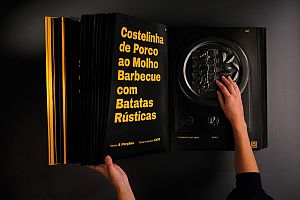
The tangible difference in the creative address of the target group people with visual impairment was underscored among others by Maggi and the Dorina Nowill Foundation for the Blind, which made recipes available with the multisensory cooking guide Cooking Blindly.
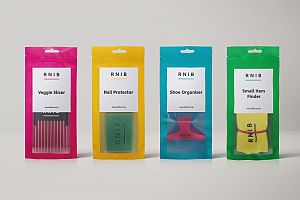
The&Partnership and the Royal National Institute for the Blind highlighted Life Hack items that are designed for use by people with a visual impairment – by turning them into desirable designer objects. They are on sale in the London Design Museum. Among others, the Life Hack products include an afro comb used as a vegetable slicer.
What applies for marketing campaigns also plays a key role regarding inclusion at the workplace, as Armin Halfar can report from many years of experience. The Managing Director and founder of the German bag specialists, Halfar, has been employing people with a disability at the company prosigno for good ten years. He is a minority shareholder, the majority shareholder is the Lebenshilfe, a non-profit organisation for people with disabilities, which came up with the idea of founding the company over 13 years ago. “We work in the direct proximity of the institution of the Lebenshilfe and have already frequently received support at short notice for processing orders. This is how the idea came about to approach the Lebenshilfe to search for a joint solution when we were building an in-house screen printing customising shop.” The arising company, prosigno gGmbH (a non-profit foundation), employs people with to a large extent invisible disabilities. As well as operating the screen printing machines they also carry out simple activities in the picking and packing department. Approx. 20 employees currently work at prosigno.
The in-house participation plays a major role here. There is indeed a strict separation in the business form – Halfar and prosigno are two separate companies – but the working climate on-site is designed to allow accessibility and inclusion – from the joint canteen and recreation rooms, through to joint events: “For us the individual person comes first. Promoting communications, creating encounters, building up a common normality – that is what counts in the everyday routine at the company. Many of the employees have given us the feedback that they can deal with the theme disability in a much more relaxed and open manner since we launched the inclusive organisation,” stated Halfar.
The jointly worked out concept is a win-win situation for both sides. On the one hand, the bag manufacturer profits from the direct inhouse customisation, from the short routes also in the communications with the customers and the associated transport cost reductions. The employment contract with prosigno gives the employees structure, allows them to get an initial foothold on the job market and beyond this to complete an apprenticeship as a screen printing technician (m/f/d). Halfar is aware that the omnipresent lack in skilled workers cannot be solved purely by integrative measures, nevertheless the experienced entrepreneur does see a lot of untapped potential in the theme inclusion for the promotional products industry: “Especially in the case of invisible disabilities such as a learning disability or chronic illnesses it is difficult to assess straightaway, how well a person can be deployed for certain tasks within the company – these are processes that have to be worked out together, where both sides have to grow together. But overall our experiences have been positive and we have won over long-term employees in the integration area. Flexibility and good work safety are decisive here – characteristics that make us an attractive employer in the region in terms of employer branding for example.”
Equal appreciation
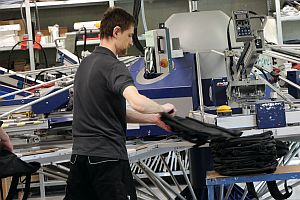
The integration company prosigno is located at Halfar’s premises and is responsible for the screen printed customisations of the bag specialists.
Robin Vogel, CEO of Promocorp, also draws a positive balance. At his company, The Peppermint Company, which belongs to the Promocorp Group and specialises in promotional sweets, Vogel has been employing people with disabilities for around 10 years. His credo is “People first!”: “We employ about 60 people with invisible disabilities, who for different reasons experience a distance to the job market. The most important thing we have learned over the past years is that you have to look at the person first and try to fit the tasks to the person and not vice versa.” Vogel considers it a challenge offering people with invisible disabilities an adequate job, but he also underlines the advantages that the employment relationship has for both parties and is delighted that in the meantime around 30 companies in Enschede, the Netherlands, where The Peppermint Company is located, have followed his example. “Companies have to fulfil strict regulations at the workplace and are audited regularly, but are also endorsed by the local government for employing people with disabilities. Thus, we can keep jobs and companies in the region that otherwise would have to go to Poland for example to keep production costs at a certain level. We needed employees for picking and packing and operating machinery and started by employing five people, now we’re up to 60 people.”
Beyond the local companies in Enschede, Vogel sees a clear added value for the promotional products industry – especially for suppliers whose processes require a lot of manual work and repetitive tasks. “Many production tasks in the promotional products industry can be done by people, who for whatever reason experience barriers to the job market. As an employer building trust and a healthy working environment is key to accommodating everybody’s needs and helping every employee grow. We also don’t separate employees from different backgrounds, we have drinks together on Fridays and barbecues in the summer – everybody is equally appreciated.”
Accessibility is key
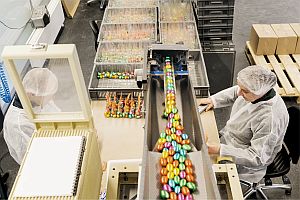
People with barriers to the job market are among others responsible for picking and packing tasks at The Peppermint Company.
For Corinne Gray the fact that inclusion means the participation of everyone goes without saying. However, the actual availability of inclusive options within the promotional products market is not a matter of course. Even though the theme adaptive fashion has already arrived on the scene at some of the large retail brands such as Tommy Hilfiger or Nike, this doesn’t apply for Promowear’s suppliers – or for the print-on-demand suppliers that URevolution commissions for implementing the designs. “We have been trying for quite some time now to make all our designs available to everyone – to offer a wide variety of sizes, which is in very high demand, as well as adaptive clothing e.g. for wheelchair users. Unfortunately, our partners have been unable to meet our needs so far, which is very frustrating. The great demand especially for plus sizes and adaptive fashion hasn’t reached the promotional products industry yet. We might have to come up with our own solution to this problem, for instance by setting up our own in-house printing shop,” confirmed Gray. Inclusive work also always involves new challenges, as Armin Halfar confirms: “A situation that may appear harmless for people from the outside such as a comment by an employee or a change in the workflows, can lead to the person no longer being able to work there,” Armin Halfar pointed out. Hence, when planning resources and deadlines, a buffer always has to be considered. Armin Halfar: “Prosigno is not a screen printing shop it is an integration company.”
Integration takes priority for Halfar, quotas come second. In spite of the uncertainties that daily operations can bring with them, the bag specialist is convinced that companies have to reflect social developments within the company in order to attain a sustainable, future-oriented alignment – in other words not artificially split up the workers into different groups, but instead create a productive solidarity: “Ideally the topic would be totally obsolete and we would be able to employ all people at a completely inclusively organised workplace.”
// Claudia Pfeifer
photos: Halfar, Nestlé Brasil, Serviceplan, The&Partnership, The Peppermint Company, URevolution, Illustration: Jens C. Friedrich, © WA Media




